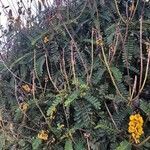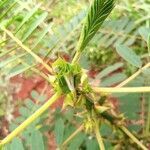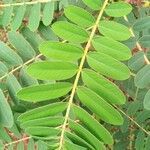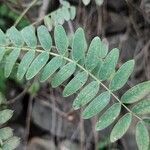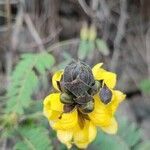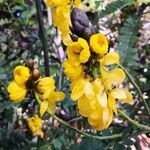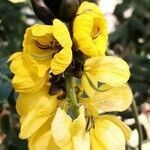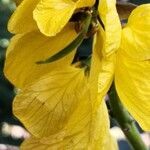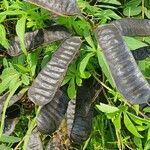Rather soft-wooded shrub, 2-4 m or more tall, unpleasant-smelling when fresh. Branchlets dark brown, sparsely pubescent. Leaves paripinnate; stipules 10-15 x 8-11 mm, broadly ovate, cordate at base, acuminate at apex, persistent; petioles 1.7-3.5(8.5) cm long, pubescent; rachis 10-25 cm long, pubescent; leaflets in 6-16 pairs, opposite, 21-55 x 6-20 mm, oblong, asymmetrically cuneate at base, acute and mucronate at apex, pubescent above and beneath. Inflorescence an axillary raceme, axis 22-34 cm long; bracts present in bud, falling before anthesis, 10-16 x 8-13 mm, broadly ovate, base cordate, apex acute, apiculate. Sepals 5, c. 13 x 5 mm, elliptic. Petals 5, yellow, with prominent darker veins particularly when dry, c. 20 x 10 mm, broadly elliptic to obovate. Stamens 10, seven of them probably fertile, two of these with filaments c. 2 mm long and anthers c. 10 mm long, five with filaments c. 2 mm long and anthers c. 5 mm long; three probably infertile with filaments c. 2 mm long and reduced anthers. Ovary c. 12 mm long, densely pubescent; stipe c. 5 mm long; style c. 12 mm long, glabrous. Pods blackish, 8-10.4 x 1.8-2.4 cm, oblong, corrugated on the flat surface, very tardily dehiscent along both sutures. Seeds dull brown, 6.5-7.5 x 3.5-5 mm, oblong, flattened, apiculate at the proximal end, with a narrowly obovate to oblong areole in the centre of each face.
Shrubs, 2.5-3 m tall. Young branches and leaves puberulent, glabrescent when old. Leaves to 35(-50) cm; stipules tardily deciduous, ovate-cordate, 6-17 mm, acuminate; petiole and rachis without glands, puberulent; petiolules very short; leaflets 8-16 pairs, abaxially farina-white, ovate-oblong or lanceolate-oblong, 3-5.5 × 1-2 cm, base rounded and oblique, apex obtuse or subacute, mucronate. Racemes in axils of leaves in upper part of branches, 10-35 cm, sometimes several arranged in a terminal leafy panicle; bracts caducous, imbricate, broadly ovate, apex subacute or acuminate. Sepals oblong-obovate. Petals yellow, oblong or obovate, shortly clawed. Stamens 10, among them functionally 2 extra large, curved, ca. 12 mm. Ovary densely yellowish or pallid pilosulose. Legume compressed, ligulate-oblong, 8-10 × 1.6-1.8 cm, leathery, bicarinate by sutures, apex with a long and slender awn, stipe 1-1.2 cm; fruiting pedicel ca. 1 cm. Seeds 9-16, obovoid-oblong, compressed. 2n = 28.
Shrub, erect, to 2.5 m high, pubescent on vegetative parts, inflorescence axes and ovary, otherwise glabrous. Leaves 10–25 cm long including a terete petiole 15–40 mm long; stipules cordate, acuminate, subpersistent; leaflets in 8–10 pairs spaced 10–20 mm apart, oblong, 20–60 mm long, 10–20 mm wide, increasing distally, acute to obtuse and mucronate; glands absent. Inflorescence dense, of 15–30 flowers, axillary; peduncle 50–70 mm long; pedicels 6–8 mm long; bracts dark brown to black, caducous. Petals to 20 mm long. Fertile stamens 2, with 7 adaxial and 1 abaxial staminodes; filaments subequal, 1–2 mm long; fertile anthers c. 10 mm long. Pod flat, c. 7 cm long, c. 18 mm wide, straight, entire. Seeds dull.
Coarse shrub, up to 1.5-5.0 m high; stems, leaves, and inflorescences sparsely pubescent with spreading hairs. Leaves 100-140 mm long. Leaflets 10 to 20 pairs per leaf, oblong-elliptic, mucronate apically, rounded basally, rachis terete. Stipules leafy, cordate, ovate with attenuate apex. Inflorescences axillary, flowers and fruits co-occurring. Flowers bright yellow drying to white, with brown veins. Flowering time Mar.? Pod stipitate, flattened, 60-120 x 15-25 mm. Valves corrugated over seeds, papery, dark brownish black, glabrate. Seeds compressed, oblong, grey-brown, bearing elliptic areole on each face.
Leaves paripinnate; stipules 10–15 × 8–11 mm, broadly ovate, cordate at base, acuminate at apex, persistent; petioles 1.7–3.5(8.5) cm long, pubescent; rachis 10–25 cm long, pubescent; leaflets in 6–16 pairs, opposite, 21–55 × 6–20 mm, oblong, asymmetrically cuneate at base, acute and mucronate at apex, pubescent above and beneath.
Stamens 10, seven of them probably fertile, two of these with filaments c.2 mm long and anthers c.10 mm long, five with filaments c.2 mm long and anthers c.5 mm long; three probably infertile with filaments c.2 mm long and reduced anthers.
Inflorescence an axillary raceme, axis 22–34 cm long; bracts present in bud, falling before anthesis, 10–16 × 8–13 mm, broadly ovate, base cordate, apex acute, apiculate.
Seeds dull brown, 6.5–7.5 × 3.5–5 mm, oblong, flattened, apiculate at the proximal end, with a narrowly obovate to oblong areole in the centre of each face.
Shrub, up to 7 m high. Stipules persistent, broadly ovate-cordate, 8-14 mm long. Petals obovate, 20-25 x 12-13 mm. Flowers bright yellow.
Pods blackish, 8–10.4 × 1.8–2.4 cm, oblong, corrugated on the flat surface, very tardily dehiscent along both sutures.
Petals 5, yellow, with prominent darker veins particularly when dry, c.20 × 10 mm, broadly elliptic to obovate.
Ovary c.12 mm long, densely pubescent; stipe c.5 mm long; style c.12 mm long, glabrous.
Rather soft-wooded shrub, 2–4 m or more tall, unpleasant-smelling when fresh.
Branchlets dark brown, sparsely pubescent.
Sepals 5, c.13 × 5 mm, elliptic.
A shrub.
